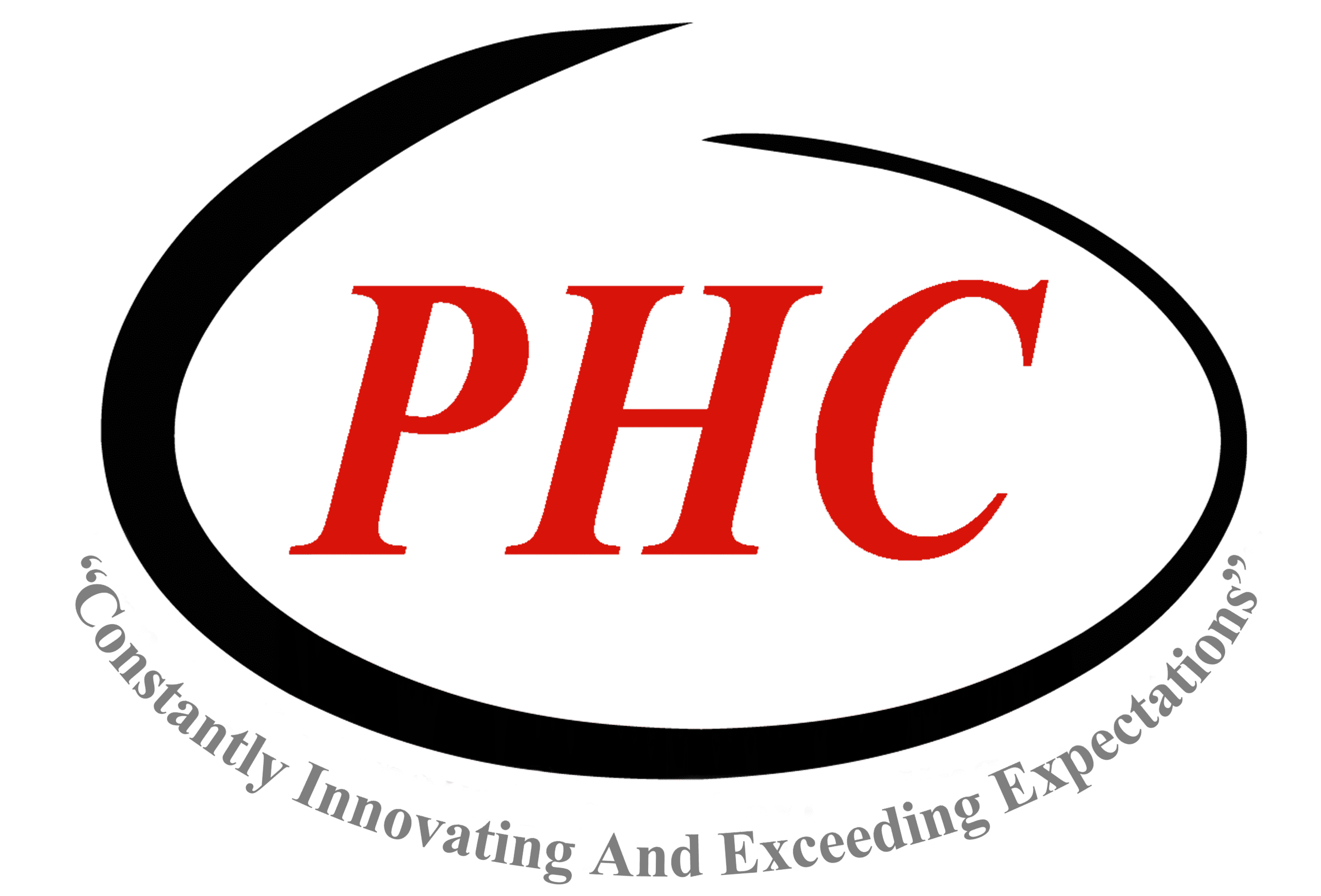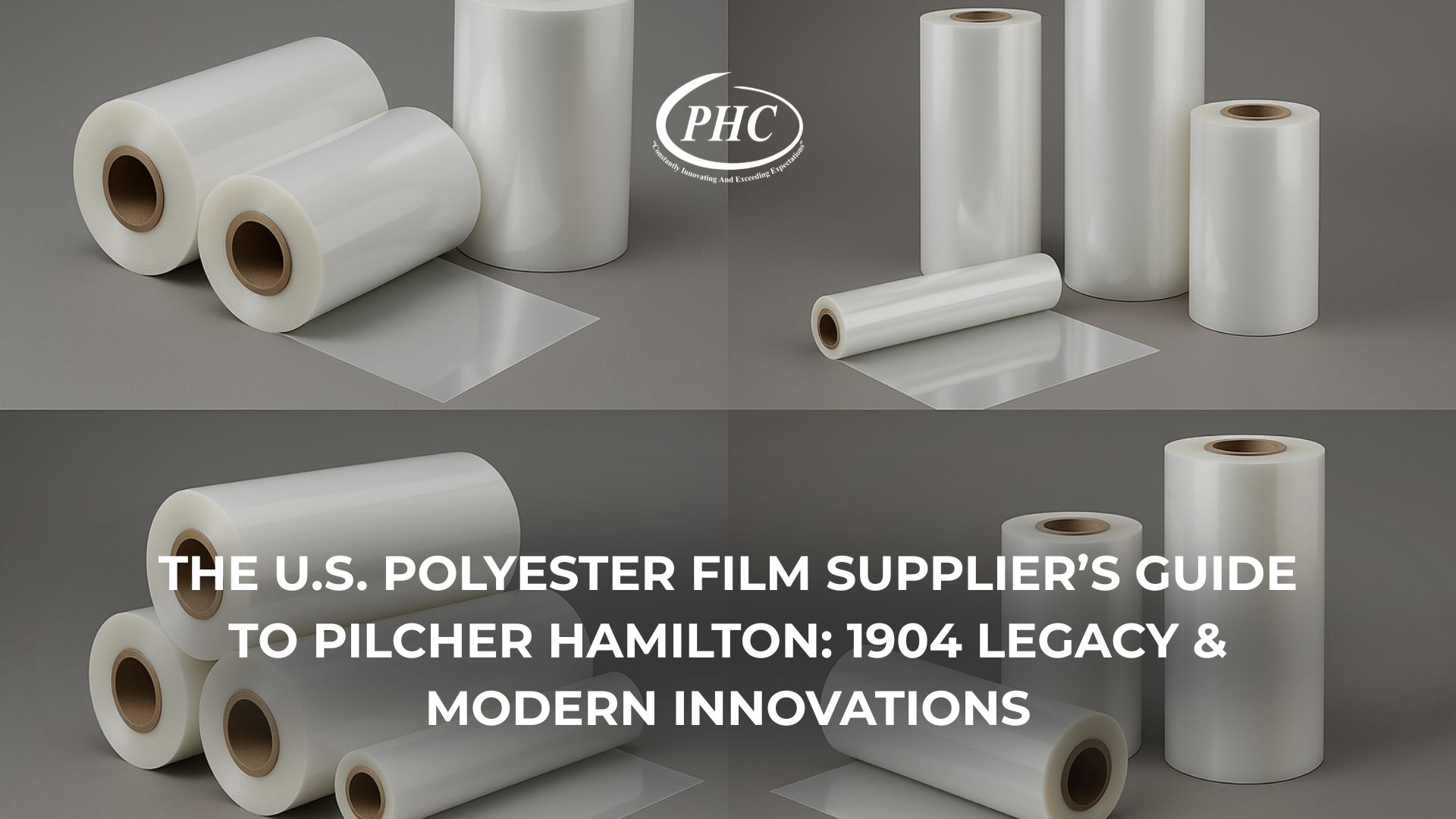What Are Polyester Films and Their Core Properties?
Polyester films (often called PET or BOPET) are biaxially oriented thermoplastic films known for tensile strength, optical clarity, and dimensional stability. They resist many chemicals, hold print exceptionally well after surface treatment, and laminate cleanly to paper, foils, and plastics. In polyester film manufacturies across the U.S., consistent gauge control, surface energy, and winding integrity are the foundations of performance. PHC complements material quality with corona treatment and specialty coatings to enhance ink anchorage, adhesion, sealability, slip, and release characteristics. For teams repeatedly asking “polyester near me,” the Greer, SC footprint shortens lead time while maintaining tight specs.
Key Applications in Packaging, Electrical & Graphics
- Packaging: Clear, opaque white, metallized, and PVDC-coated films for pouch webs, lidding, snack barriers, pharma overwraps, and anti-fog refrigerated displays. See PHC’s packaging lineup (https://www.pilcherhamilton.com/packaging-lineup-usa-pet-films-for-every-packaging-application/).
- Electrical: UL-grade insulation, slot liners, phase insulation, and cable wraps. Explore electrical UL grades (https://www.pilcherhamilton.com/electrical-insulating-ul-approved/).
- Graphics/Industrial: Release liners, protective laminates, high-clarity print bases, label stocks, and technical films. View high-clarity graphic grades (https://www.pilcherhamilton.com/high-clarity-graphic-grades/).
Advantages Over Traditional Materials
| Attribute | Polyester (PET) | Polypropylene (PP) | PVC | BON (BOPA) |
| Clarity/Gloss | Excellent | Very good | Good | Good |
| Dimensional Stability | Excellent | Good | Good | Very good |
| Barrier (with metal/PVDC) | Excellent | Moderate | Moderate | Good |
| Heat Resistance | High | Moderate | Moderate | Moderate |
| Print/Lamination | Excellent after treatment | Good | Good | Very good |
Future Trends in Sustainable Polyester Films
Expect growth in post-consumer recycled (PCR) content, recyclable structures, and coatings that enable mono-material streams. PHC’s U.S. converting and coating know-how keeps designs agile as regulations evolve. If you’re comparing suppliers under “polyester near me,” evaluate not just film specs but also downstream converting—slitting, sheeting, winding, toll converting, and coating—to ensure results scale.
History Since 1904, Product Spotlights & Services
History & Mission (since 1904): PHC’s roots in materials craftsmanship inform today’s specification-driven PET programs. Learn our story (https://www.pilcherhamilton.com/about/) and U.S. footprint (https://www.pilcherhamilton.com/locations/).
Product Spotlights:
- Metallized PET for brilliant reflectivity and barrier (https://www.pilcherhamilton.com/metallized/).
- PVDC-Coated PET for robust moisture/oxygen barrier (https://www.pilcherhamilton.com/pvdc-coated/).
- Anti-fog grades for cold-chain clarity (see general purpose & packaging families: https://www.pilcherhamilton.com/all-products/).
Core Services: - Slitting (precision widths, clean edges): https://www.pilcherhamilton.com/slitting/
- Sheeting (flatness, stack quality): https://www.pilcherhamilton.com/sheeting/
- Winding (roll geometry, tension control): https://www.pilcherhamilton.com/winding/
- Toll Converting (speed from spec to shipment): https://www.pilcherhamilton.com/toll-converting/ and https://www.pilcherhamilton.com/pet-converting-services-the-fastest-path-from-spec-to-shipment/
Case Snapshot
A regional snack brand sought a polyester film supplier for metallized webs delivering higher crispness retention. PHC tuned metal adhesion and slip via in-house coating and corona treatment. Converting yields rose, defects fell, and the brand shifted all SKUs to the PHC structure. This reflects what polyester film manufacturies can achieve when film, surface, and finishing steps are engineered as a system.
FAQs (People-Also-Ask Style)
- What makes PET suitable for high-clarity packaging?
Its inherent gloss and stiffness produce shelf-ready clarity; treatments improve print anchorage. - How do I spec a barrier film without over-engineering?
Start with shelf-life targets, then match metallized or PVDC-coated structures via PHC’s film specs hub (https://www.pilcherhamilton.com/filmspecs/). - Do you support UL electrical applications?
Yes—see electrical insulating PET options (https://www.pilcherhamilton.com/electrical-insulating-ul-approved/). - What if my line needs higher slip?
Explore high COF/low slip guidance (https://www.pilcherhamilton.com/high-cof-low-slip/) and request a tuned coating. - Can PHC provide anti-fog for produce packs?
Yes; anti-fog PET is part of our packaging lineup (https://www.pilcherhamilton.com/all-products/). - Where can I download technical data?
Visit technical datasheets (https://www.pilcherhamilton.com/technical-datasheets/). - Do you toll-convert customer-supplied rolls?
Yes—toll converting services are available (https://www.pilcherhamilton.com/toll-converting/). - Is PHC local to the Carolinas?
Yes—850 South Buncombe Road, Greer, South Carolina; ideal when you search “polyester near me.”
Visit Pilcher Hamilton at 850 South Buncombe Road, Greer, South Carolina, or search “polyester near me” to connect.
Exploring Slitting, Sheeting, Winding & Toll Converting with a U.S. Polyester Film Supplier
What Are Polyester Films and Their Core Properties?
PET’s modulus, clarity, and dimensional stability make it ideal for high-speed lines. In polyester film manufacturies, converting success depends on film surface energy, winding tension, and defect control. PHC matches film traits to downstream needs with corona treatment (https://www.pilcherhamilton.com/corona-treated/) and coatings (https://www.pilcherhamilton.com/coating/). For those searching “polyester near me,” local converting reduces logistics risk and improves schedule certainty.
Key Applications in Packaging, Electrical & Graphics
- Packaging: Slit rolls for form-fill-seal, lidding, and laminations. See heat-sealable families (https://www.pilcherhamilton.com/heat-sealable/).
- Electrical: Precise slit widths and defect-free edges for UL applications (https://www.pilcherhamilton.com/electrical-insulating-ul-approved/).
- Graphics/PSA: Release liners and adhesive-friendly bases (https://www.pilcherhamilton.com/release-liners-psas-usa-pet-films-for-adhesive-performance/).
Advantages Over Traditional Materials
| Converting Factor | PET Benefit | Practical Result |
| Stiffness & Flatness | Stable web path | Better register at speed |
| Surface Treatment | Reliable ink/adhesion | Fewer print pick-offs |
| Edge Integrity | Cleaner slitting | Less dust, fewer splices |
| Thermal Stability | Less curl/stretch | Tighter tolerances post-process |
Future Trends in Sustainable Polyester Films
Converting will increasingly integrate PCR PET, clear-on-clear label stocks, and recyclable mono-material structures. PHC’s toll converting (https://www.pilcherhamilton.com/toll-converting/) lets teams trial designs quickly. When you compare “polyester near me,” confirm your partner’s PCR handling, QA release criteria, and data-rich technical datasheets (https://www.pilcherhamilton.com/technical-datasheets/).
Services in Focus (Slitting, Sheeting, Winding, Toll Converting)
- Slitting: Tight width control, COF tuning support, verified roll geometry (https://www.pilcherhamilton.com/slitting/).
- Sheeting: Flat stacks for die-cutting/printing (https://www.pilcherhamilton.com/sheeting/).
- Winding: Tension-managed rolls for downstream stability (https://www.pilcherhamilton.com/winding/).
- Toll Converting: Intake inspection, spec confirmation, and rapid delivery (https://www.pilcherhamilton.com/pet-converting-services-the-fastest-path-from-spec-to-shipment/).
Case Snapshot
A label converter needed precise silicone-coated release films with narrow widths and low dust. PHC upstream-treated the base (https://www.pilcherhamilton.com/adhesive-silicone-coated-base-films/) and slit to spec. Scrap dropped, press uptime improved, and order cadence stabilized—an example of how polyester film manufacturies align materials, surfaces, and converting.
FAQs
- What tolerances can PHC support?
PET slitting is engineered to tight width and roll geometry targets—validated via QC before shipment. - Can PHC slit customer-supplied jumbo rolls?
Yes—see toll converting (https://www.pilcherhamilton.com/toll-converting/). - Do you offer sheeting for graphics?
Yes—sheeting for flatness and stack integrity (https://www.pilcherhamilton.com/sheeting/). - How is slip controlled?
Via base film selection, additives, and coatings tuned to COF windows (https://www.pilcherhamilton.com/coating/). - Is corona treatment available?
Yes—see corona-treated options (https://www.pilcherhamilton.com/corona-treated/). - Do you stock metallized or PVDC webs for slitting?
Yes—metallized (https://www.pilcherhamilton.com/metallized/) and PVDC-coated PET (https://www.pilcherhamilton.com/pvdc-coated/). - Where are you located?
850 South Buncombe Road, Greer, South Carolina—helpful when you search “polyester near me.”
Do you provide data support?
Yes—access film specs and technical datasheets online (https://www.pilcherhamilton.com/filmspecs/, https://www.pilcherhamilton.com/technical-datasheets/).
Top Metallized & PVDC-Coated PET from a U.S. Polyester Film Supplier
What Are Polyester Films and Their Core Properties?
BOPET’s stiffness and clarity make it a stable barrier substrate. Metallization upgrades oxygen/light barrier and reflectivity; PVDC coatings enhance moisture/oxygen holdout with good clarity. In polyester film manufacturies, adhesion, surface energy, and winding integrity determine downstream quality. PHC aligns base film, metallization, and topcoats, so lines run cleaner—ideal for “polyester near me” searches needing dependable supply.
Key Applications in Packaging, Electrical & Graphics
- Food/Confectionery: Metallized PET for crisp textures and “foil look” appeal (https://www.pilcherhamilton.com/metallized/).
- Moisture-Sensitive Goods: PVDC-coated PET for freshness and aroma retention (https://www.pilcherhamilton.com/pvdc-coated/).
- Labels/Graphics: Printable treated sides for inks/adhesives; see print & laminate guidance (https://www.pilcherhamilton.com/print-laminate-win-usa-pet-films-for-packaging-graphics/).
Advantages Over Traditional Materials
| Need | Metallized PET | PVDC-Coated PET | Notes |
| Oxygen Barrier | Excellent | Excellent | Choice depends on clarity & lamination path |
| Moisture Barrier | Good | Excellent | PVDC excels in MVTR control |
| Visual Impact | Mirror-like | Clear | Match to brand/graphics goals |
| Process | Metallizer | Coating line | Both need tuned surface energy |
Future Trends in Sustainable Polyester Films
Expect barrier designs that maintain performance with less weight, plus recyclable structures where practical. Polyester film manufacturies will continue tuning coatings for mono-material strategies and PCR compatibility. PHC’s barrier guidance (https://www.pilcherhamilton.com/barrier-that-delivers-usa-pet-films-for-maximum-protection/) and BOPET/BON laminations resources (https://www.pilcherhamilton.com/bon-pet-laminations-usa-high-performance-packaging-films/) aid concept selection.
Product Spotlights & Services
- Metallized PET: Explore standards and clear twistable variants (https://www.pilcherhamilton.com/elevating-packaging-standards-with-metallized-polyester-films/, https://www.pilcherhamilton.com/twistable-clear-metallized/).
- PVDC-Coated PET: See our barrier lineup (https://www.pilcherhamilton.com/pvdc-coated/).
- Support Services: Coating (https://www.pilcherhamilton.com/coating/), slitting (https://www.pilcherhamilton.com/slitting/), sheeting (https://www.pilcherhamilton.com/sheeting/), winding (https://www.pilcherhamilton.com/winding/).
- For teams searching “polyester near me,” PHC’s Greer base ensures repeatable lead times.
Case Snapshot
A beverage brand needed clear windows plus barrier. PHC proposed a PVDC-coated PET with a heat-sealable web, maintaining window clarity while achieving performance—illustrating how polyester film manufacturies unify coatings and converting.
FAQs
- When should I choose metallized PET vs. PVDC PET?
Select metallized for mirror appearance and robust OTR; PVDC when moisture holdout and clarity are crucial. - Will metallized PET delaminate?
With proper anchorage and corona levels, adhesion is robust; PHC validates interfaces during development. - Can I print over PVDC?
Yes—pair with appropriate primers/treatments and confirm ink system compatibility. - What about anti-fog windows?
Combine anti-fog pockets within laminates; PHC assists in layer sequencing. - Do you supply twistable clear metallized films?
Yes—see twistable clear metallized (https://www.pilcherhamilton.com/transforming-packaging-with-twistable-clear-metallized-polyester-films/). - How do I request film specs?
Use film specs and technical datasheets (https://www.pilcherhamilton.com/filmspecs/, https://www.pilcherhamilton.com/technical-datasheets/). - Where are you located?
850 South Buncombe Road, Greer, South Carolina—perfect if you’re searching “polyester near me.” - Do you provide converting?
Yes—slitting, sheeting, winding, toll converting with QA checkpoints.
Sustainable PCR & Heat-Sealable Options from a U.S. Polyester Film Supplier
What Are Polyester Films and Their Core Properties?
PET offers stiffness, clarity, and print fidelity with solid temperature tolerance. In polyester film manufacturies, PCR content, melt filtration, and surface energy must remain compatible with inks, adhesives, and seal layers. PHC’s post-consumer recycled portfolio (https://www.pilcherhamilton.com/post-consumer-recycled/) and heat-sealable options (https://www.pilcherhamilton.com/heat-sealable/) are engineered for converting reliability. For teams asking “polyester near me,” Greer-based programs bring speed and consistency.
Key Applications in Packaging, Electrical & Graphics
- Packaging: Flow wraps, lidding, sustainable stand-up pouches, windowed structures (PCR + heat-sealable).
- Electrical: PCR is increasingly evaluated where design allows, with focus on dielectric consistency.
- Graphics/Labels: Clear print bases and release liners that support PSA performance (https://www.pilcherhamilton.com/release-liners-psas-usa-pet-films-for-adhesive-performance/).
Advantages Over Traditional Materials
| Sustainability Lever | PET Path | Practical Benefit |
| PCR Content | Integrated in base film | Circularity & brand goals |
| Recyclable Designs | PET/PET, PET-paper | Streamlined disposal where accepted |
| Process Stability | Heat-sealable grades | Sealing windows for speed & integrity |
Future Trends in Sustainable Polyester Films
More PCR grades, better sealant chemistries, and coatings that enable mono-material streams. Polyester film manufacturies will center on lifecycle metrics and converting data. PHC’s sustainability resources (https://www.pilcherhamilton.com/sustainability-first-usa-pet-films-green-converting-solutions/) and twistable clear metallized guidance (https://www.pilcherhamilton.com/transforming-packaging-with-twistable-clear-metallized-polyester-films/) support design choices.
Product Spotlights & Services
- PCR PET: Engineered for print/lamination consistency (https://www.pilcherhamilton.com/post-consumer-recycled/).
- Heat-Sealable PET: For reliable seals and pack integrity (https://www.pilcherhamilton.com/heat-sealable/).
- Twistable/Clear Metallized: Visual pop with package functionality (https://www.pilcherhamilton.com/twistable-clear-metallized/).
- Converting Services: Slitting, sheeting, winding, toll converting (https://www.pilcherhamilton.com/all-services/).
Case Snapshot
A snack brand needed a lighter structure without losing crispness. PHC paired PCR PET with a tuned heat-seal layer. Seal windows widened, line speed increased, and weight targets were met—showcasing how polyester film manufacturies balance sustainability and performance.
FAQs
- Will PCR PET print like virgin PET?
With proper treatment and QC, yes—PHC confirms ink anchorage and lamination steps. - Are heat-sealable PET films FDA compliant?
PHC will align structures to relevant requirements; confirm your end use during specification. - Can I integrate PCR in clear windows?
Yes—validate clarity and haze for your brand standard. - Does PCR affect sealing?
Formulations are tuned so sealing windows remain robust; verify on your equipment. - Do you offer guidance on recyclable structures?
Yes—see sustainability resources (https://www.pilcherhamilton.com/sustainability-first-usa-pet-films-green-converting-solutions/). - Where can I see packaging options?
Explore packaging lineup (https://www.pilcherhamilton.com/packaging-lineup-usa-pet-films-for-every-packaging-application/). - Where are you located?
850 South Buncombe Road, Greer, South Carolina—easy for “polyester near me” searches. - Do you supply anti-fog options too?
Yes—see all products (https://www.pilcherhamilton.com/all-products/).
Visit Pilcher Hamilton at 850 South Buncombe Road, Greer, South Carolina, or search “polyester near me” to connect.

